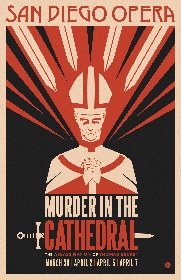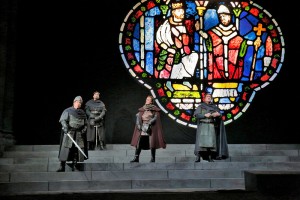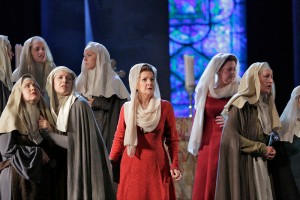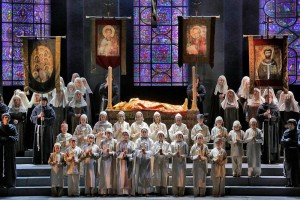FITTING FOR A SAINT
Although he wrote at least 15 complete operas, Ildebrando Pizzetti (1880-1968) is not a familiar name, even to many in the opera world. The first-generation modernist Italian composer yielded other forms of classical music (concertos, chamber works, sonatas) but also composed hundreds of film scores – many uncredited; the Sinfonia del fuoco he composed for a particularly dramatic scene in Giovanni Pastrone’s epic silent film Cabiria (1914) is one of his greatest achievements; according to AllMusic’s Dave Lewis, it is “perhaps the earliest film score that sounds a little like what dramatic film music would eventually become many years later.”
More to the point, Pizzetti’s early film work sounds a bit like what his 1953 opera Murder in the Cathedral (Assassinio nella Cattedrale) sounds like. When you attend San Diego Opera’s confusing but nonetheless immensely satisfying production of Murder – which premiered at La Scala, Milan in 1958 – you should listen to it as though you were listening to “dramatic film music” – the sort of melody-free cinematic composition that is often written to service the dialogue. Think Erich Wolfgang Korngold, who wrote the scores for Sea Hawk (1940) and The Adventures of Robin Hood (1938).
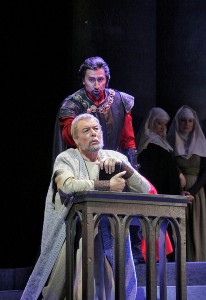 Pizzelli is not a man who serves up arias for your listening pleasure. Certainly there are buried character themes and even the ingenious use of Gregorian chants sprinkled throughout, but this is music written to service the text, versus the bel canto operas, which were written to service the singer.
Pizzelli is not a man who serves up arias for your listening pleasure. Certainly there are buried character themes and even the ingenious use of Gregorian chants sprinkled throughout, but this is music written to service the text, versus the bel canto operas, which were written to service the singer.
Conducted by La Scala’s Donato Renzetti, the two-hour, two-act opera with intermezzo is an adaptation (libretto also by Pizzetti) of an Italian translation of T.S. Eliot’s verse play of the same name. In 1163, English King Henry II (dramatized in Goldman’s The Lion in Winter) and Archbishop of Canterbury Thomas Becket clashed over the respective power roles of church and state. So tempestuous was the quarrel that Becket bolted to France to gather backing for the Catholic Church against the forces of the State of Henry II. The opera begins seven years later in 1170; Becket returns to his Canterbury cathedral, chooses martyrdom rather than reconcile with his former friend the King, and is murdered by four of Henry’s knights (I’m not giving away the ending here – it is called Murder in the Cathedral).
Pizzetti closely follows Eliot’s play, which means that much of the drama onstage at the Civic Theatre is ambiguous, especially in Act I: Beckett arrives amidst the fretting chorus (the Women of Canterbury) and three unnamed priests who want them to stop fretting (bafflingly, there are also two female Corypheuses, or leaders of the dramatic chorus, who are also named Chorus). Then, four “tempters” arrive, but due to Ian D. Campbell’s undefined direction – which basically consists of gorgeous stage pictures made up of clumps of people – we have no idea that these flesh-and-blood characters are different aspects of Beckett’s inner self.
Yet after the intermezzo of a Beckett sermon, Act II springs to life as the four Knights arrive to give Beckett the opportunity to return to political power alongside King Henry while at the same time accusing him of treason. Beckett will not back down and willingly accepts the assassins’ swords. With the dramatic stakes intensified, a respectful first half becomes a thrilling second half.
Returning to San Diego opera is Italian bass Ferruccio Furlanetto, who lavishes us with a resonant vocal profundity. He also manifests Beckett’s emotional turmoil, evoking an Archbishop who is drawn in by sainthood and lured by power while realizing that martyrdom and pleasure are both human weaknesses. As he says to his tempters, “The last temptation is the greatest treason: To do the right deed for the wrong reason.”
The four Tempters are portrayed by the same actors who portray the four Knights. OK, it’s a bit addling, but tenor Joel Sorensen, baritone Malcolm MacKenzie, bass-baritone Ashraf Sewailam, and bass Kevin Langan brought distinct characterizations to generically written roles. Both soprano Susan Neves and mezzo-soprano Helene Schneiderman were surprisingly powerful as the suffering Second and First Chorus, respectively.
Allow yourself to become accustomed to the declamatory libretto with haste; the sooner you do, the sooner this gorgeous production will invade your senses. Listen for the unique and exquisite orchestrations while you take in the sumptuous technical elements: Ralph Funicello’s gothic interior set is replete with incredible stain glass recreations backlit by Alan Burrett; Funicello’s front stage stairway allows for a virtual parade of Denitsa Bliznakova’s authentic costumes; notice the detail in Steven W. Bryant’s wig and makeup design. All of these, combined with the Children’s Chorus (members of St. Paul’s Cathedral Choristers), make the finale one of the most stunning stage pictures in memory.
It is even fitting for a saint.
photos by Ken Howard
Murder in the Cathedral
San Diego Opera at the Civic Theatre
scheduled to end on April 7, 2013
for tickets, call (619) 533-7000 or visit http://www.sdopera.com
